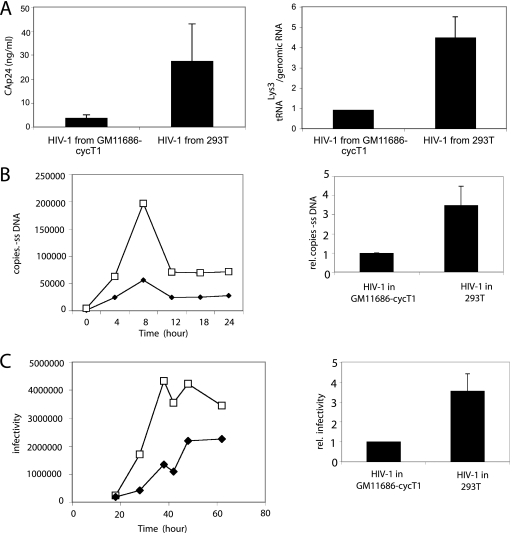FIG. 1.
HIV-1 produced in murine cells show reduced  (tRNALys3) packaging, −SS DNA synthesis, and infectivity. 293T and GM11686-cycT1 cells were spin transfected with HIV-1, and the resulting virions were analyzed. (A) Viral production and
(tRNALys3) packaging, −SS DNA synthesis, and infectivity. 293T and GM11686-cycT1 cells were spin transfected with HIV-1, and the resulting virions were analyzed. (A) Viral production and  packaging. (Left) Extracellular amount of CAp24 per milliliter of culture medium. (Right) Total viral RNA was isolated and analyzed by dot blot hybridization using DNA probes specific for
packaging. (Left) Extracellular amount of CAp24 per milliliter of culture medium. (Right) Total viral RNA was isolated and analyzed by dot blot hybridization using DNA probes specific for  and viral genomic RNA. (B) −SS DNA synthesis. SupT1 cells were infected with equal amounts of HIV-1 produced from either 293T cells or GM11686-cyc-T1 cells. DNA was extracted at different times postinfection. Early (R-U5) minus-strand cDNA production was monitored by real-time PCR as described in Materials and Methods. (Left) Time course of DNA production. Symbols: □, HIV-1 produced in 293T cells; ♦, HIV-1 produced in GM11686-cycT1 cells. (Right) Relative (rel.) production of −SS DNA at 8 h. (C) Viral infectivity. Equal amounts of viral CAp24 were used to challenge TZM-bl indicator cells, and productive infection was measured as the induction of luciferase activity. (Left) Time course of infection. Symbols: □, HIV-1 produced in 293T cells; ♦, HIV-1 produced in GM11686-cycT1 cells. (Right) Relative (rel.) infectivity at 28 h postinfection, normalized to HIV-1 produced in GM11686-cycT1 cells.
and viral genomic RNA. (B) −SS DNA synthesis. SupT1 cells were infected with equal amounts of HIV-1 produced from either 293T cells or GM11686-cyc-T1 cells. DNA was extracted at different times postinfection. Early (R-U5) minus-strand cDNA production was monitored by real-time PCR as described in Materials and Methods. (Left) Time course of DNA production. Symbols: □, HIV-1 produced in 293T cells; ♦, HIV-1 produced in GM11686-cycT1 cells. (Right) Relative (rel.) production of −SS DNA at 8 h. (C) Viral infectivity. Equal amounts of viral CAp24 were used to challenge TZM-bl indicator cells, and productive infection was measured as the induction of luciferase activity. (Left) Time course of infection. Symbols: □, HIV-1 produced in 293T cells; ♦, HIV-1 produced in GM11686-cycT1 cells. (Right) Relative (rel.) infectivity at 28 h postinfection, normalized to HIV-1 produced in GM11686-cycT1 cells.

